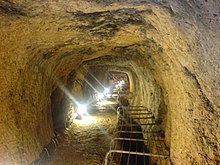Tunnel of Eupalinos

Inside the Eupalinian aqueduct, Samos, in one of its most spacious parts.
|
|
| Overview | |
|---|---|
| Location | Samos Island, Greece |
| Coordinates | 37°41′38″N 26°55′48″E / 37.694°N 26.930°ECoordinates: 37°41′38″N 26°55′48″E / 37.694°N 26.930°E |
| Status | Open |
| Operation | |
| Opened | ca. 6th century BCE |
| Technical | |
| Length | 1036m |
The Tunnel of Eupalinos or Eupalinian aqueduct (Modern Greek: Efpalinio orygma, Ευπαλίνειο όρυγμα) is a tunnel of 1,036 m (3,399 ft) length in Samos, Greece, built in the 6th century BC to serve as an aqueduct. The tunnel is the second known tunnel in history which was excavated from both ends (Ancient Greek: αμφίστομον, amphistomon, "having two openings"), and the first with a geometry-based approach in doing so. Today it is a popular tourist attraction.
In the sixth century BC, Samos was ruled by the famous tyrant Polycrates. During his reign, two groups working under the direction of the engineer Eupalinos from Megara dug a tunnel through Mount Kastro to build an aqueduct to supply the ancient capital of Samos (today called Pythagoreion) with fresh water. This was of utmost defensive importance, as the aqueduct ran underground it was not easily found by an enemy who could otherwise cut off the water supply. The Eupalinian aqueduct was used for a thousand years, as proved from archaeological findings. It was rediscovered in 1882-1884 and today is open to visitors.
The Eupalinian aqueduct or ditch, is cited by Herodotus (Histories 3.60), without whom it would not have been discovered:
The tunnel took water from an inland spring, which was roofed over and thus concealed from enemies. A buried channel, with periodic inspection shafts, winds along the hillside to the northern tunnel mouth. A similar hidden channel, buried just below the surface of the ground, leads from the southern exit eastwards to the town of Pythagoreion.
In the mountain itself, the water used to flow in pipes in a separate channel several metres below the human access channel, connected to it by shafts or by a trench.
...
Wikipedia
